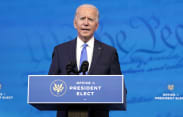The Dow on Monday pulled back from an intraday record to close lower, as investors weighed the U.S. rollout of a COVID-19 vaccine against tightening restrictions implemented in New York City and parts of Europe ahead of Christmas.
How did major benchmarks do?
- The Dow Jones Industrial Average DJIA closed with a loss of 184.82 points, or 0.6%, at 29,861.55. After hitting an intraday 30,325.79 record, it booked its biggest daily percentage drop since Nov. 30, according to Dow Jones Market Data.
- The S&P 500 SPX shed 15.97 points, 0.4%, ending at 3,647.49, extending losses to a fourth-session, its longest losing streak since Sept. 21.
- The Nasdaq Composite COMP advanced 62.17 points, 0.95, closing at 12,440.04.
Stocks posted a mixed finish Friday, leaving benchmarks with modest losses for the week. The Dow saw a 0.6% weekly fall, while the S&P 500 fell 1% and the Nasdaq declined 0.7%. The small-cap Russell 2000, however, saw a sixth straight weekly gain, rising 1%.
What drove the market?
“The market is swinging back and forth because of the potential for further lockdowns,” Brent Schutte, chief investment strategist at Northwestern Mutual Wealth Management Company, told MarketWatch.
But even if New York City follows much of California into a “full lockdown,” as Mayor Bill de Blasio warned was possible on Monday, Schutte thinks investors instead should focus on “stimulus and the vaccine,” which he sees as likely to broaden the economy “for the first time since 2018,” when the U.S. and China trade war intensified with tariffs.
“It’s that tug of war,” he said.
Read: U.S. heads for sobering COVID-19 death toll of 300,000 as vaccinations begin
Pfizer Inc. PFE over the weekend began shipping the vaccine it created with Germany’s BioNTech SE BNTX around the country, after the Food and Drug Administration late Friday granted emergency authorization for its use.
Wall Street also was hopeful about the prospects of a new round of spending by the U.S. government in a crunch week, after leaders from both parties over the weekend signaled they would be open to setting aside the most contentious topics in long-running talks.
A bipartisan group of Senate and House lawmakers, which has pushed for a compromise $908 billion plan, was reportedly set to release a two-part plan yet on Monday: $160 billion of state and local aid and liability protections into a package, with another $748 billion aid plan that would provide $300 a week in additional state unemployment benefits for four months, $300 billion in aid to small businesses and $35 billion for health-care providers, according to several news reports.
Jean Boivin, head of BlackRock’s Investment Institute, called the start of vaccine distribution a “game-changer,” in a Monday note, even as U.S. jobs data has disappointed in recent weeks and several European counties in recent days announced stricter lockdowns to curb infections ahead of Christmas.
“We now know we are building a bridge to somewhere, providing clarity for policy makers, households and companies about getting to a post-COVID stage,” Boivin’s team wrote.
The U.S. counted 184,248 new cases on Sunday, and at least 1,357 people died, according to a New York Times tracker. The U.S. has averaged 210,112 cases a day over the past week, up 30% from the average two weeks earlier. A record 109,331 COVID-19 patients were in U.S. hospitals on Sunday, according to the COVID Tracking Project, topping the record of 108,487 set a day earlier.
The economic calendar was largely empty Monday. The main event this week will likely be the Federal Reserve’s final policy meeting of 2020 on Tuesday and Wednesday.
Check out: 4 things to watch when Fed meets Wednesday
The Fed isn’t expected to make any policy changes, but may continue to underline the need for politicians to provide fiscal support to the pandemic-hit economy, analysts said.
“Financial conditions remain conducive to economic activity, so the Fed is biding its time. At their meeting this week, the Fed is likely to provide additional qualitative guidance on its asset purchase program, tying it to future economic outcomes, but stop short of stepping up the amount of asset purchases,” said Neil Dutta, head of economics at Renaissance Macro Research, in a note.
Outside the U.S., U.K. Prime Minister Boris Johnson and European Commission President Ursula von der Leyen agreed on Sunday to scrap a deadline and go “the extra mile” to reach a post-Brexit trade deal.
Which companies were in focus?
- AMC Entertainment Holdings Inc. AMC shares plunged 18.6% after the struggling movie theater operator said it would sell shares.
- Boeing Co. BA shares closed 0.7% lower, after The Wall Street Journal reported that new defects detected in 787 “Dreamliners” would set back deliveries further.
- German biotech CureVac CVAC said it enrolled the first participant for a final-stage clinical study of its COVID-19 vaccine candidate. Shares rose 2.5%.
- Walt Disney Co. DIS shares fell 3.7% Monday after a ratings cut to “market perform” from “outperform” from a BMO analyst.
- Shares of Alexion Pharmaceuticals Inc. ALXN jumped 29.2%. AstraZeneca PLC UK:AZN AZN said over the weekend it had agreed to buy the Boston-based company for $39 billion in cash and stock. AZN shares fell 7.8%.
- Shares of 3M Co. MMM fell 0.5% after reporting total sales for the month of November rose 8% from a year ago to $2.9 billion. The company said that “although significant macroeconomic uncertainty remains,” it expects fourth-quarter sales of $8.2 billion to $8.4 billion, which surrounds the FactSet consensus of $8.27 billion.
- Google users in the U.S., Europe, India and other parts of the world were temporarily unable to access Gmail accounts, watch YouTube videos or get to online documents during an outage early Monday. Shares of Google parent Alphabet Inc. GOOG shed 1.2% and GOOGL 1.3%.
- Shares of Virgin Galactic Holdings Inc. SPCE plunged 17.4% Monday, after the space tourism company said a recent test flight failed to reach space as planned, but did land safely.
What did other markets fare?
- In Asia, the Shanghai Composite CN:SHCOMP rose 0.6%, while Hong Kong’s Hang Seng Index HK:HSI shed 0.4%. Japan’s Nikkei 225 JP:NIK rose 0.3%.
- In Europe, the Stoxx 600 Europe index XX:SXPP closed 0.4% higher, while London’s FTSE 100 benchmark UK:UKX rose 0.2%.
- The yield on the 10-year Treasury note BX:TMUBMUSD10Y rose less than a basis point to 0.891% as investors monitored safe-haven assets amid vaccine optimism. Yields and bond prices move in opposite directions.
- The ICE U.S. Dollar Index DXY, a measure of the currency against a basket of six major rivals, fell 0.3%.
- Oil futures booked gains, with the U.S. benchmark CL adding 0.9% to settle at $46.99 a barrel on the New York Mercantile Exchange.
- Gold futures GCG21 lost ground, settling 0.6% lower at $1,832.10 an ounce, near a two-week low.








